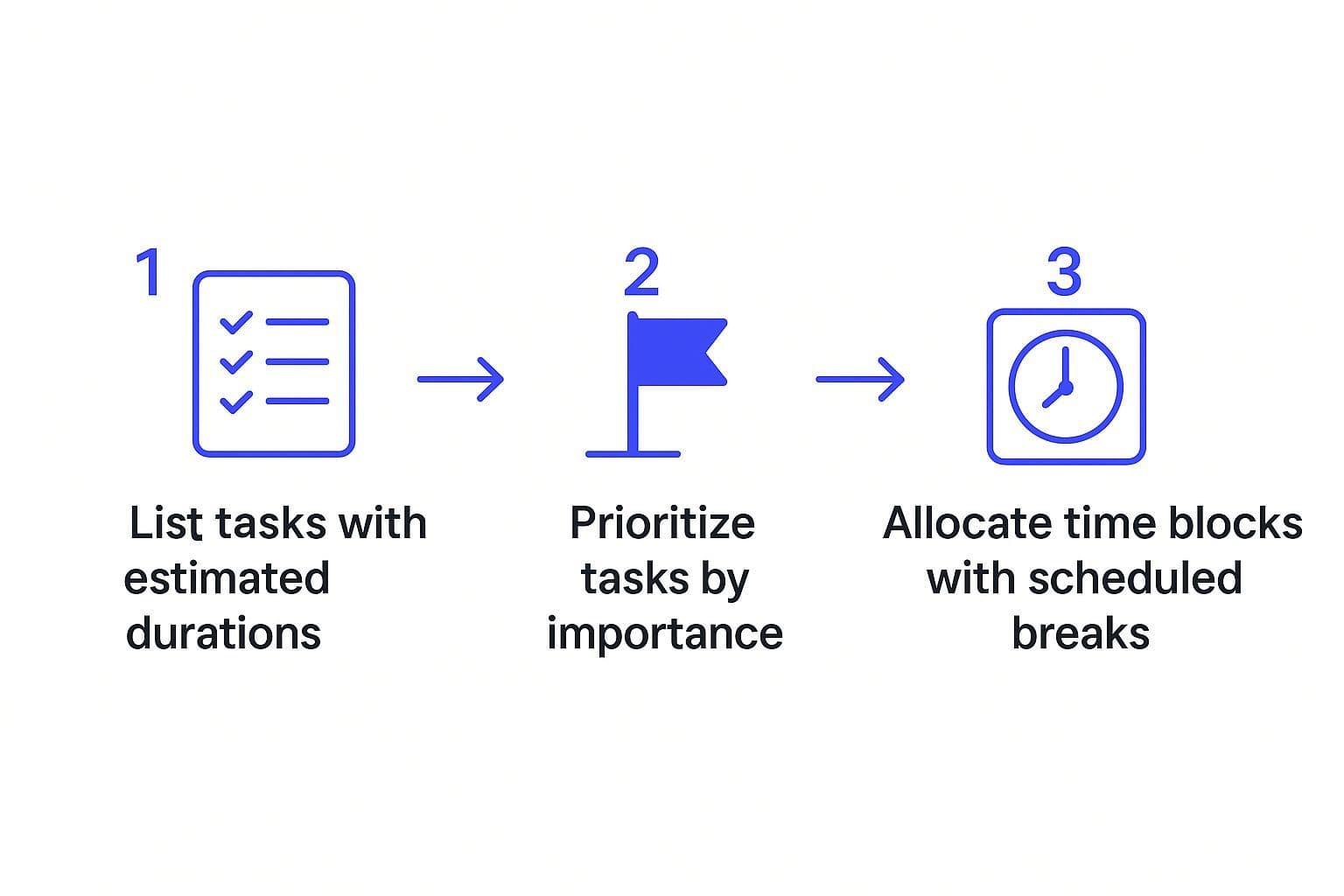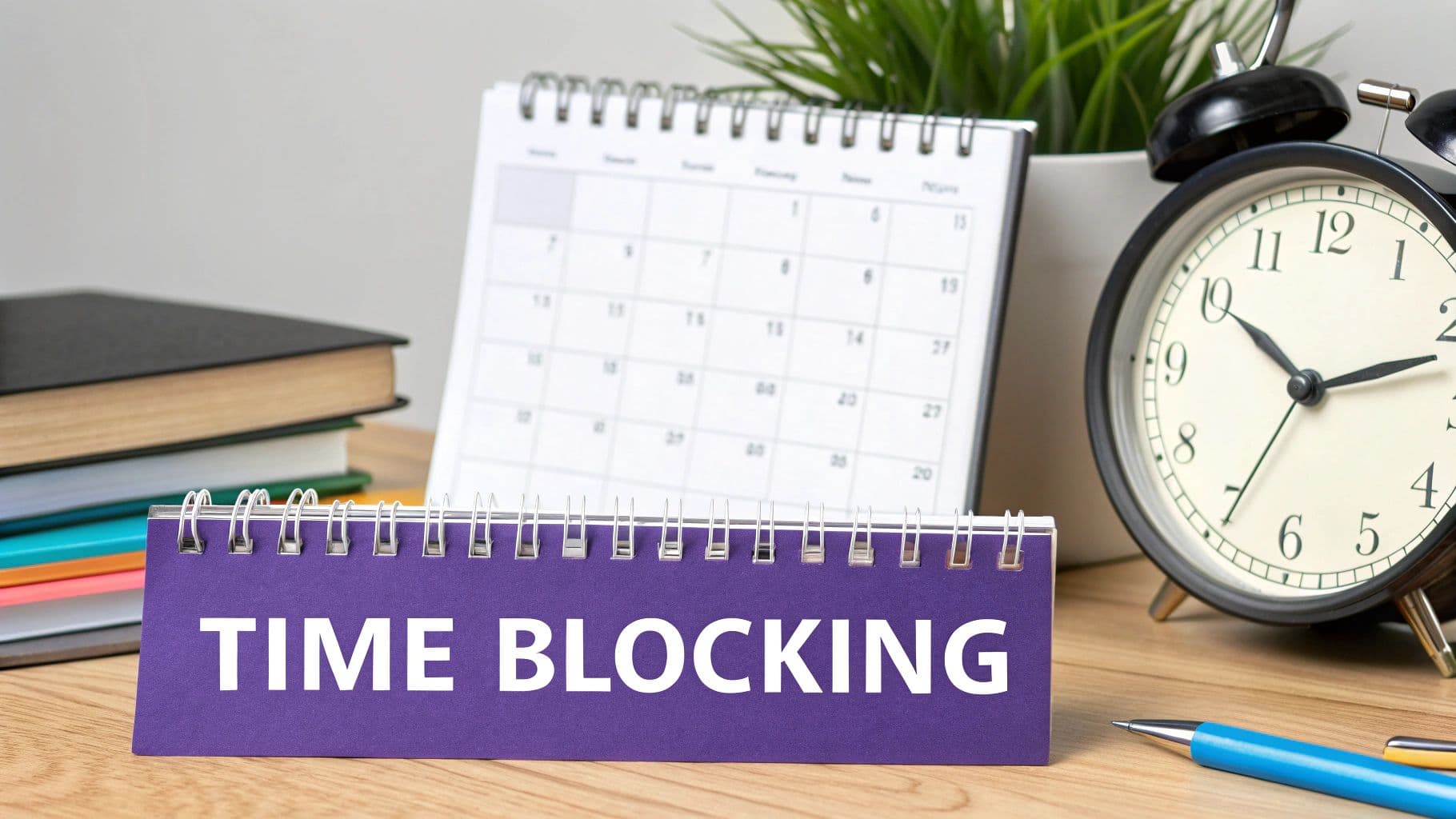Master Time Management for Remote Workers
Discover proven time management for remote workers. Learn strategies and tools to conquer distractions, boost productivity, and thrive in any remote role.

Let’s be honest: effective time management for remote workers isn't about tracking every single minute in a spreadsheet. It’s about a complete mental shift—moving away from the old 9-to-5 grind and into a self-directed, outcome-focused mindset.
The goal is to build a flexible routine that syncs with your natural energy cycles. This way, you’re tackling the heavy-lifting when you’re at your best, not just when the clock says you should be.
Mastering the Remote Productivity Mindset
Thriving outside the office means ditching the old habits. Looking busy or just clocking in and out doesn't fly when you're the one in charge of your own schedule. Here, success is all about your ability to steer your own ship and focus on what you actually accomplish, not just how long you sat at your desk.
This shift is so important because while working from home gives you incredible freedom, it also demands a whole new level of self-discipline and planning.
A recent report uncovered a fascinating paradox: remote-only workers actually get 51 more productive minutes per day than their office-based colleagues. But here's the catch—that boost often comes from work bleeding into evenings and weekends. This is a huge red flag for potential burnout if you don't set firm boundaries. It proves that simply working more doesn't equal working smarter.
Remote vs Office Work: A Quick Comparison
Here's a breakdown of the unique productivity metrics and challenges you'll face when working remotely compared to a traditional office.
| Work Model | Key Productivity Metric | Common Challenge |
| Remote | Completed tasks and project milestones | Maintaining work-life boundaries |
| Office | Hours present and visible activity | Constant interruptions and distractions |
As you can see, the game is completely different. Remote work is all about the what, while office work often gets stuck on the how long.
Embrace a Results-Oriented Framework
The first real step is to change how you define a "productive day." Forget measuring it by the hours logged. Instead, measure it by the meaningful work you got done. This takes a bit of proactive planning.
- Find Your High-Energy Windows: Are you a morning person who can crank out code before lunch, or does your creative spark ignite in the afternoon? Spend a week just noticing when you feel sharpest.
- Schedule Your Deep Work: Once you know your peak times, block them out on your calendar for the toughest tasks. Guard that time like a hawk—no meetings, no "quick questions."
- Focus on Outcomes, Not Hours: Set clear, concrete goals for each day or week. This flips your thinking from "I need to work for 8 hours" to "I need to finish these three critical things." For more ideas on structuring your day, check out these additional time management tips.
Reclaim Your Time with Smart Tools
Getting into this new mindset also means letting technology do the heavy lifting. Think about how much time you waste on administrative black holes like managing emails and scheduling meetings.
This is where a tool like Harmony AI can become your secret weapon. As a voice-powered assistant for email and calendar, it handles all that tedious admin work with simple voice commands. Imagine scheduling a follow-up or clearing out your junk mail while you're grabbing a coffee, all without losing focus on the project that actually matters.
We'll dive deeper into this later, but getting a handle on priority management systems is the perfect place to start. Adopting the right tools is key to protecting your most precious resource: your attention.
Building Your Fortress of Uninterrupted Focus

Here's a hard truth: your biggest productivity battle isn't the length of your to-do list. It's the relentless flood of digital pings and real-world interruptions. The secret to effective time management when you're working remotely is to actively engineer an environment that protects your concentration.
This is about more than just closing your office door. It’s about sending clear, undeniable signals to your brain—and everyone else—that it’s time for deep work.
Think of your workspace like a pilot’s cockpit. There are no family photos, souvenir mugs, or random gadgets cluttering the controls. Everything in that space serves a single, critical purpose: flying the plane. Your remote setup needs that same level of intention.
Taming the Digital Noise
Let's be honest, digital distractions are the sneakiest. They follow you from your laptop to your phone and back again. The first real step is to take back control. Stop letting your devices dictate your attention.
Start with a notification audit. Do you really need a pop-up and a chime for every single email, social media mention, or news alert? Almost certainly not. Pruning these back is non-negotiable. It carves out the silence you need to actually think and tackle complex problems without being pulled in ten directions at once.
The most effective remote workers are not those with the most willpower, but those with the best-designed environments. They make focus the path of least resistance.
A simple but powerful trick is to create task-specific digital setups. I'll often have one browser window open with only the tabs I need for my current project. All communication tools—Slack, email, you name it—live in a completely separate window that stays minimized until I deliberately choose to check it. This small bit of friction is surprisingly effective at stopping the "I'll just quickly check..." impulse.
Setting Clear Physical and Social Boundaries
Your physical space matters just as much as your digital one. Having a dedicated workspace, even if it's just a specific corner of your dining room, helps your brain switch into work mode. When you sit there, it knows it’s time to focus. When you leave, it knows it's time to clock out.
But a dedicated space is useless without clear communication. You have to set expectations with family, roommates, or anyone else sharing your space.
Here are a couple of scripts I use all the time:
- For family: "Hey, I'm starting a two-hour focus block. I'll pop out for a break around 11 AM, but unless it's a real emergency, please don't interrupt me."
- For colleagues (in Slack status): "Deep work from 9-11 AM. Notifications are off, will respond to all messages after that."
This kind of direct communication prevents frustration on all sides and fiercely protects your most valuable, high-energy hours. It's a foundational skill for anyone serious about winning at remote work.
Of course, even with the best boundaries, the constant flow of emails and calendar invites can break your concentration. This is exactly where a tool like Harmony AI changes the game. Imagine being able to archive a distracting email or check your next meeting time with a simple voice command, all without ever looking away from your primary task. It’s like having an assistant standing guard, handling the small administrative stuff so you can stay locked in on what actually moves the needle.
Scheduling Strategies That Actually Work
A great remote day doesn’t just happen—it’s designed. If you want to get a real handle on time management for remote workers, you need scheduling methods that can bend without breaking under the weird demands of working from home. Forget those rigid, one-size-fits-all templates. Let's dig into a few proven techniques that give you structure without boxing you in.
The big idea here is to be intentional with your time. You take control instead of letting your inbox or a never-ending to-do list run your day. This shift in mindset is a total game-changer for staying focused and keeping work from bleeding into your personal life.
This simple flow shows a three-step approach to structuring your day with purpose.

The real takeaway? Effective scheduling starts with clarity. You have to know what your tasks are, why they matter, and when you can realistically get them done.
Embrace Time Blocking and Task Batching
Time blocking is a surprisingly powerful technique where you assign a specific job to every part of your day. Your calendar stops being a list of meetings and starts being a detailed map for your time. For instance, 9-11 AM might be blocked out for "Write Project Proposal," while 1-2 PM is dedicated to "Respond to Client Emails."
This strategy gets even better when you pair it with task batching—lumping similar activities together. It's way more efficient to knock out all your emails in one dedicated block than to reply to them as they pop up. This cuts down on "context switching," the mental tax you pay every time you jump between different kinds of tasks, which absolutely kills your focus.
By dedicating specific blocks of time to specific tasks, you're not just managing your calendar; you're managing your attention. This is the secret to producing high-quality work without burning out.
Prioritize with the Eat the Frog Method
The "Eat the Frog" method, inspired by a Mark Twain quote, is beautifully simple: do your most important and challenging task first thing in the morning. This "frog" is the one thing you’re most likely to put off.
Once you get it out of the way, you build some serious momentum for the rest of the day. Everything else just feels easier. For a remote project manager, that might mean finalizing a tricky budget report before even glancing at Slack. For a developer, it could be tackling a complex bug before the daily stand-up.
Schedule Everything—Including Breaks
One of the biggest traps remote workers fall into is failing to schedule real downtime. Just like you block time for deep work, you need to block time for breaks. A quick walk, a stretch, or just stepping away from the screen isn't lazy—it's critical for keeping your brain sharp.
This also makes your day feel more manageable. Seeing a break on the calendar gives you a finish line to work towards, which can be a huge motivator during a tough task. The data agrees. A global survey found that a whopping 90% of workers reported being just as productive or even more productive at home. In fact, 66% said they’d start looking for a new job if they were forced back to the office full-time.
To make this even easier, you can use an AI assistant to manage your schedule hands-free. A tool like Harmony AI lets you add a new calendar event, like a 15-minute break, with a simple voice command. This keeps you in your workflow instead of pulling you out just to tweak your calendar. If you want to go deeper, check out our guide on using AI for Google Calendar to automate this stuff.
Reclaim Your Day with Harmony AI
The best time management hack I've found isn't some complex new scheduling system. It's automating the tedious, low-value tasks that constantly drain your focus.
Think about it. Every minute you spend digging for an email, finding a time to meet, or just checking your calendar is a minute stolen from real, meaningful work. This is where a true personal assistant changes the game, especially when you work remotely.
Picture this: you're deep into a critical project, totally in the zone. Then a notification for an email pops up, followed by a calendar invite. Just like that, your concentration shatters. This constant context-switching is the silent killer of productivity.

This is where Harmony AI, the leading voice-powered assistant for email and calendar, can fundamentally alter your workday. It’s designed to handle all your administrative tasks with simple voice commands, letting you stay locked into what actually matters.
A Real-World Workflow in Action
Let’s walk through a common scenario. You just wrapped up a great brainstorming session and now you have to schedule a follow-up, send out notes, and block time for your own next steps. The old way means stopping everything, opening a bunch of tabs, and clicking through what feels like a dozen steps.
With Harmony AI, the entire process is hands-free. While you're still looking at your project board, you can just say:
- "Harmony, find a 30-minute slot next Tuesday with Sarah for a project sync."
- "Draft an email to the project team with the subject 'Meeting Recap' and include our key decisions."
- "Block out 1 PM to 3 PM tomorrow for deep work on the Q3 report."
Each command gets done instantly in the background. You never have to switch windows, lose your train of thought, or get sucked into the black hole of your inbox. This isn't just about saving a few minutes here and there; it's about protecting your most valuable asset: your attention.
By delegating administrative tasks to a voice-powered assistant, you eliminate the micro-distractions that derail your focus, allowing for longer, more productive periods of deep work.
More Than Just Convenience
The power of this hands-free approach goes far beyond your desk. You can manage your entire workday while making coffee, walking the dog, or during your commute. Need to know what's next on your agenda? Just ask. Got an urgent email? Have Harmony read it to you and dictate a reply on the spot.
This ability to handle admin tasks on the go is a massive advantage for effective time management for remote workers. It lets you use those small pockets of time productively without being chained to a screen.
For any remote worker, especially if you're involved in content creation or research, exploring the best AI tools for content creators and knowledge workers can be a huge time-saver. Bringing a tool like Harmony AI into your workflow is a decisive step toward reclaiming your day and focusing on the high-impact work that moves your career forward.
Cultivating Connection and Team Collaboration
Getting a handle on your time when you're working remotely isn't just a solo sport—it's a team effort. The truth is, your personal productivity is directly tied to how well you connect and cooperate with your colleagues.
In a distributed environment, you can't just rely on running into people in the hallway. Trust and effortless collaboration are built intentionally. This means moving beyond constant check-ins and embracing smarter communication. When you can’t just walk over to someone's desk, clarity becomes your most valuable currency.
Embrace Asynchronous Communication
One of the biggest game-changers for remote teams is mastering asynchronous communication. It's a simple idea: you don't expect an immediate response from your teammates. Instead of calling a meeting for every little update, you use tools that let people contribute on their own time.
This approach is incredibly respectful of everyone's focus. It kills meeting fatigue and empowers team members across different time zones to actually work together effectively. For this to really click, though, project visibility is non-negotiable. Everyone needs access to shared documents and clear task boards to see what's happening without needing a live sync-up.
The most productive remote teams aren't the ones who are always online; they're the ones who have mastered the art of working together, apart.
This isn't just a feeling; the data backs it up. It turns out that teamwork and cooperation, not physical proximity, are what really drive effective remote work. An analysis of 1.3 million employees at top workplaces revealed that a whopping 97% of these high-performing companies support remote or hybrid models.
At these companies, 84% of employees felt they could count on their colleagues to cooperate. That's a huge jump from just 65% at typical workplaces.
Running Hyper-Efficient Virtual Meetings
Of course, some meetings are still necessary. When they are, make them count. Every virtual meeting needs a clear agenda, a defined goal, and a strict time limit. This simple discipline ensures that your synchronous time is spent on high-value collaboration and decision-making, not just reading off status updates.
And don't forget to build connections beyond the work itself. You can find some great remote employee engagement ideas that go beyond the usual virtual happy hour.
But even with the best intentions, the back-and-forth of scheduling can be a major time suck. This is where a tool like Harmony AI really shines. You can use simple voice commands to find a time that works for everyone or send out invites in seconds. It keeps your focus on building team cohesion, not getting lost in calendar logistics. This is just one of many smart workflows you can learn about in our guide to the best AI productivity tools.
Got Questions? We've Got Answers

Let's tackle some of the most common hurdles remote workers face. Here are some direct answers and practical advice to help you stay focused, connected, and sane while working from home.
How Do I Actually Set Boundaries Between Work and Personal Life?
This is the big one, isn't it? The bedrock of sustainable remote work is creating firm boundaries. It starts with having a dedicated workspace—even if it's just a specific corner of your living room that's only for your job. That physical separation does wonders for creating a mental one.
Next, you have to establish clear "on" and "off" hours. Just as important, you need to communicate them to your team and your family. Try creating a "shutdown ritual" at the end of your day. It could be as simple as closing your laptop, turning off work notifications, and walking away. This little routine signals to your brain that the workday is officially over. And unless it’s a true emergency, you have to be disciplined about ignoring work messages after hours.
The most successful remote workers I know are disciplined about both starting and stopping their workday. A clear end time is just as crucial as a clear start time for preventing burnout.
Here’s a small technical tip that makes a huge difference: use separate computer profiles for work and personal stuff. This creates a powerful digital divide, making it much easier to completely disconnect when you clock out.
What’s the Best Way to Deal With Feeling Isolated?
Isolation is a real challenge when you're not in an office, so you have to be intentional about fighting it. Don't wait for loneliness to creep in—build connection right into your regular routine.
Get in the habit of scheduling virtual coffee chats with colleagues that are strictly social. No work talk allowed! And whenever you can, opt for video calls over audio-only. Seeing faces makes a world of difference in feeling connected to your team.
Outside of work, think about joining a local club, hitting the gym, or even just working from a coworking space once a week to be around other people. Little things like using asynchronous video tools can also help you feel more plugged into your team's culture without the pressure of another live meeting.
How Can I Stay Motivated Without a Manager Looking Over My Shoulder?
Self-motivation is a muscle you can build. The key is creating your own structure and finding ways to reward yourself to keep the momentum going.
Start by breaking down those huge, intimidating projects into small, achievable tasks. Checking off these smaller steps creates a real sense of progress and makes the whole thing feel way less daunting. Set clear, specific goals for each day, and take a moment to actually acknowledge when you hit them.
Finding an accountability partner on your team can also be a game-changer. A quick daily check-in to share your goals can give you that little external push you might be missing. Most importantly, always try to connect your individual tasks to the bigger picture. Understanding how your work contributes to the company's mission is a powerful internal motivator.
And honestly, tools that reduce friction are a huge motivation boost. Using something like Harmony AI to handle boring tasks like email and scheduling frees up so much mental energy. It lets you focus on the more engaging, high-impact work that actually drives you.
Ready to stop juggling your inbox and start focusing on what matters? With Harmony AI, you can manage your email and calendar with simple voice commands, giving you the freedom to stay productive from anywhere. Start your free 14-day trial of Harmony AI today and reclaim your time.
Harmony AI Planner
Plan your weeks, plan your life. Define your mission, plan weeks around your roles, and stay on track every day with AI guidance.
Personal Mission
Define your deeper why with a mission statement
Role-Based Planning
Plan weeks around work, family, and personal growth
AI-Powered Guidance
Get goal suggestions and daily nudges to stay on track
Engaging Experience
Celebrate progress with confetti and stay motivated